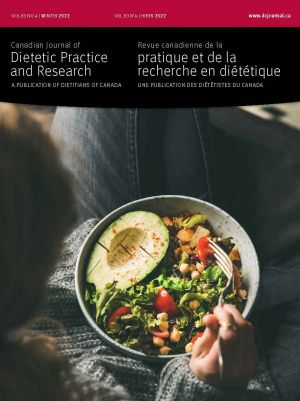Volume 72 • Number 4 • December 2011
Chair’s Message
Editor’s Message
Research
Purpose: Several studies show that malnutrition is prevalent in health care facilities, especially among elderly patients and nursing home residents. Although validated screening tools exist, little evidence exists on the feasibility of implementing nutrition screening in health care facilities. We examined New Brunswick health care professionals’ perceptions of and practices involving nutrition screening in elderly clients, as well as barriers to screening. Methods: A survey was conducted with questionnaires intended for physicians, nurses, and dietitians. Results: Participants were 457 health care professionals (physicians, 34.6%; nurses, 50.3%; dietitians, 15.1%). Perceptions of nutrition screening varied. For example, most nurses (94.7%) and dietitians (98.5%) indicated that screening was important/ very important, while only 63.5% of physicians indicated this. Screening methods also differed among professionals and few used a screening tool. Several barriers to implementing nutrition screening were reported, such as lack of time, lack of professional resources, and clients’ short stays. Conclusions: These findings will help professionals address the feasibility of implementing standardized screening tools in health care facilities. A more consistent and systematic approach for detecting populations at high nutritional risk may result.
Purpose: Obese people find energy-dense food more reinforcing than do their non-obese peers, and reinforcement influences food intake. We examined how the degree of adiposity, measured by body mass index (BMI), is associated with the relative reinforcing value of energy-dense snack foods versus fruits and vegetables in overweight and obese people. Methods: Ninety-two overweight or obese students in introductory psychology courses completed questionnaires on age, sex, BMI, hunger, smoking status, dietary restraint, and hedonic (liking) ratings for energy-dense snack foods and fruits and vegetables. The questionnaire also was used to evaluate the relative reinforcing value of these snack foods in comparison with fruits and vegetables. Results: The BMI predicted the relative reinforcing value of energy-dense snack food. This positive relationship remained significant after we controlled for age, sex, dietary restraint, hunger, smoking status, and snack food hedonics. Conclusions: The greater the degree of overweight and obesity, the greater the motivation to obtain energy-dense snack foods. Because the rewarding value of food is a strong determinant of energy intake, a useful approach to preventing and treating obesity may be introducing pharmacological or behavioural nutrition intervention to reduce the rewarding value of energydense snack foods, or increasing the rewarding value of fruits and vegetables.
Purpose: Recently, antioxidants have taken centre stage in media and advertising messages. While 80% of Canadians think they are well-informed about nutrition, many are confused about the health effects of specific nutrients. Forty-six percent of Canadians seek information from newspapers and books, and 67% of women rely on magazines. We examined the content and accuracy of antioxidant health messages in Canadian women's magazines. Methods: The top three Canadian magazines targeted at women readers were selected. A screening tool was developed, pilot tested, and used to identify eligible articles. A coding scheme was created to define variables, which were coded and analyzed. Results: Seventy-seven percent of 36 magazine issues contained articles that mentioned antioxidants (n=56). Seventyone percent (n=40) of articles reported positive health effects related to antioxidant consumption, and 36% and 40% of those articles framed those effects as definite and potential, respectively (p<0.01). Conclusions: The articles sampled conveyed messages about positive antioxidant health effects that are not supported by current evidence. Improved standards of health reporting are needed. Nutrition professionals may need to address this inaccuracy when they develop communications on antioxidants and health risk.
Purpose: We assessed principals’ perceptions about the level of school nutrition policy (SNP) implementation in Prince Edward Island elementary schools, objectively evaluated how closely elementary schools are following SNP regulations for types and frequency of foods offered at school, and explored principals’ beliefs about the key enablers and barriers to SNP implementation. Methods: Phase I involved a cross-sectional survey of principals’ assessment of perceived and actual adherence to SNP components. Phase II included in-depth interviews to explore principals’ perceptions about factors influencing policy adherence. Descriptive statistics were generated. Thematic content analysis was used to identify themes. Results: Forty-one (93%) principals participated in Phase I, and nine of these participated in Phase II. The level of implementation of SNP components varied. Seventy-four percent of all foods sold were categorized as allowed by the SNP; 68% of schools sold at least one “not allowed” food. Key barriers included lost revenue, a higher cost of healthy foods, and limited availability of policy-allowed foods. Enablers were a high level of community support, ready access to food suppliers, and active parent volunteers. Conclusions: While schools are making progress in implementing the SNP, challenges remain. Identifying and communicating strategies for healthy fundraising activities and finding ways to involve parents in SNP implementation are recommended.
Purpose: In this mixed-methods case study, we explored factors influencing the adoption and implementation of the Alberta Nutrition Guidelines for Children and Youth within recreational facilities, and assessed the impact of their implementation on the food environment. Methods: Qualitative data were generated via interviews, observations, and document reviews. The quality of the food environment was assessed using validated and newly developed food environment assessment tools. Results: Whereas few barriers existed in terms of adopting the guidelines, implementing them proved much more challenging. Implementation was impeded by concerns about the lack of profitability of healthy items, time, and resource constraints. Guidelines that do not restrict the availability of unhealthy options are better accepted by stakeholders. Implementation of the guidelines supported creation of a healthy food environment, but the availability of healthy items remained very limited within the concession (16%) and vending machines (20%), and children continued to purchase primarily unhealthy items. Conclusions: Findings suggest that children choose healthy options insufficiently when unhealthy items are present. Thus, although introducing the nutrition guidelines in a nonrestrictive format may have been advantageous in some ways, they should be strengthened over time so that they recommend near or total elimination of unhealthy options.
Perspectives in Practice
The American Dietetic Association Nutrition Care Process (NCP) is designed to improve patient care and interdisciplinary communication through the consistent use of standardized nutrition language. Supported by Dietitians of Canada, the NCP has been gaining prominence across Canada. In spring 2009, registered dietitians at Providence Health Care, an academic, multisite health care organization in Vancouver, British Columbia, began using the NCP with a focus on nutrition diagnosis. The success of nutrition diagnosis at Providence Health Care has depended on support from the Clinical Nutrition Department leadership, commitment from the NCP champions, regularly scheduled lunch-and-learn sessions, revised nutrition assessment forms with a section for nutrition diagnosis statements, and the Pocket Guide for International Dietetics & Nutrition Terminology (IDNT) Reference Manual. Audit results from June through August 2010 showed a 92% nutrition diagnosis completion rate for acute-care and long-term care sites within Providence Health Care. Ongoing audits will be used to evaluate the accuracy and quality of nutrition diagnosis statements. This evaluation will allow Providence Health Care dietitians to move forward with nutrition intervention.
We compared the effect on weight regain of behaviour modification consisting of either a gourmet cooking course or neurolinguistic programming (NLP) therapy. Fifty-six overweight and obese subjects participated. The first step was a 12-week weight loss program. Participants achieving at least 8% weight loss were randomized to five months of either NLP therapy or a course in gourmet cooking. Follow-up occurred after two and three years. Forty-nine participants lost at least 8% of their initial body weight and were randomized to the next step. The NLP group lost an additional 1.8 kg and the cooking group lost 0.2 kg during the five months of weight maintenance (NS). The dropout rate in the cooking group was 4%, compared with 26% in the NLP group (p=0.04). There was no difference in weight maintenance after two and three years of follow-up. In conclusion, weight loss in overweight and obese participants was maintained equally efficiently with a healthy cooking course or NLP therapy, but the dropout rate was lower during the active cooking treatment.
An interview guide was created for qualitative evaluation of the impact of Practice-based Evidence in Nutrition (PEN) on dietetic practice, and its success as a medium for knowledge translation and transfer (KTT). The Delphi technique was used to bring together a diverse group of experts (n=7) with extensive knowledge in KTT and evidence-based practice (EBP); these experts developed the interview guide content. The technique is an effective means of gathering expert input to inform evaluation tool development, particularly in the absence of accepted evaluation guidelines or pre-existing evaluation tools. Although challenges exist with the Delphi technique, it is an adaptable method that can be modified to meet a variety of needs. During this project, the technique was modified to meet specific needs, including participants’ partial anonymity and starting material to reduce the number of required rounds. The resulting interview guide contained open-ended questions focused on respondents’ understanding of EBP and PEN, use of PEN by dietitians in other disciplines, perceptions of the quality/usefulness of PEN, and barriers to and facilitators of PEN use.
Increased child and youth overweight and obesity, as well as significant health effects associated with obesity, have led to recommendations for multicomponent prevention programs. In 2005 to 2006, the former Calgary Health Region (now Alberta Health Services) had an opportunity to develop, deliver, and evaluate an early intervention service for families with children at risk for overweight and obesity. Using available evidence and with access to key advisors, core team members developed and implemented a curriculum for a family-focused, behaviour-based education program entitled Make It HAPPEN. A health-centred approach based on the physical, mental, and social well-being of the whole child was used. Physical, selfesteem, and quality-of-life measures were included in program evaluation. After the program, statistically significant reductions in body mass index (BMI) percentile and z-score were seen, as were increases in quality of life. Self-esteem improved significantly for children with initial BMI percentiles of at least 98. Evaluation results indicate that an effective program can be developed with limited resources to meet best practice needs. Potentially, such programs could be integrated into other community obesity prevention programs or within primary health services models.
Folic acid reduces the risk of neural tube defects. As approximately 50% of pregnancies are unintended, women of reproductive age should be aware of the importance of folic acid. We reviewed the existing literature on these women’s knowledge of folic acid and neural tube defects. Databases searched were PubMed, CINAHL, and Health Reference Center Academic. We used terms such as “folic acid knowledge” and “folic acid awareness” to search articles published from 1998 to 2010. Awareness of the benefits of folic acid before conception and during pregnancy was low, although knowledge levels were associated with education and household income. Women who were already knowledgeable about folic acid cited health care professionals, magazines and newspapers, and radio and television as common sources of information. Effective knowledge translation is needed to ensure that women are informed about the benefits of folic acid during the reproductive years. This knowledge will allow them to make informed decisions about folic acid consumption. Health care professionals play an influential role in promoting folic acid knowledge among women of childbearing age. Lower levels of knowledge among women with lower levels of education and/or household income must be addressed.
Report
Purpose: Effects on energy metabolism of a test meal and a two-week dietary intervention were observed in men with metabolic syndrome (MetS). Both the meal and the intervention included foods containing fish-derived n-3 polyunsaturated fats (PUFA). Methods: Six men with MetS (46.7 ± 12.1 years, 37.2 ± 5.6 kg/m2, mean ± standard deviation) completed two test days, separated by a 14-day dietary intervention during which they consumed at least 2.0 g per day of n-3 PUFA from supplied foods. Pre- and post-intervention measurements included body composition, resting metabolic rate (RMR), and the thermic effect of food (TEF) measured for six hours after ingestion of a test meal consisting of 1.43 g of fish-derived n-3 PUFA. Results: Intakes of n-3 PUFA increased over the 14-day intervention, from 0.43 g per day ± 0.48 to 2.92 g per day ± 1.97 (p=0.013), while no changes were observed in total energy intakes, weight, body composition, or RMR (all p>0.05). The TEF increased by 51.3% (p=0.036), and the non-protein respiratory quotient decreased by 36.0% (p=0.700). Conclusions: Subjects increased their intake of fish-derived n-3 PUFA in an isocaloric manner while maintaining body weight and composition, and increased the TEF. More studies with larger sample sizes and longer intervention periods are required to confirm the use of fish-derived n-3 PUFA as a therapeutic dietary strategy for people with MetS.










